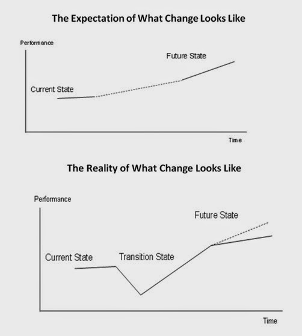Originally published in University of Arizona Global Campus Forward Thinking Blog, July 23, 2020: https://www.uagc.edu/blog/groups-teams-and-positive-interdependence-suggestions-for-managing-organizational-change
Change forces have altered the way we live and work. Change forces such as government, politics, economics, technology, sociocultural, and natural- and human-related forces (Weiss, 2015) are a constant. These change forces have directly or indirectly impacted us in many different ways. Covid-19, for example, forced many employees to work from home and created many challenges in our world.
As such, organizations are in a state of constant readiness, are continuously planning, improvising, and implementing their strategies and plans in response to these change forces. They are action learning and dealing with change forces in the present, and they are experiencing endless change continuums.
“Change occurs at many levels of the organizations. It occurs at the organizational level, within groups and teams, and at individual levels. Creating successful change is the goal, and organizations work to build on the right leadership, strategies, culture, structure, and systems” (Davis 2014, par. 2).
One way to manage change and ensure high-quality performance is to create group structures. For example, group and team structures can lead change initiatives, manage tasks, be responsible for designing products and services, implement change, and nurture and guide others in their transformation. Group structures are a sound strategy for creating positive outcomes and results.
What is Organizational Change? The 3 Different Types
Organizations are dynamic and are constantly adapting and learning. Successful organizations follow the four traits of organizational learning, which are constant readiness, continuous planning, improvised implementation, and action learning. The types of changes organizations make depend on their forecasts, and what they make of their present and future situations.
The types of change organizations can make are as follows (Weiss, 2015):
- Developmental change, which is fine tuning
- Transitional, change, which is larger scale incremental adjustments
- Transformational change, which is larger scale change
Managing Change and Change Continuums
To get from a current state to a desired state is called a “change continuum.” In a highly dynamic organization, it is not uncommon to have several types of changes being made all at once and many change continuums going on at the same time within an organization. It’s important to create the right changes and then manage the change processes.
So what does a change continuum look like? Here is a visual I have shared with my teams when managing and when consulting on organizational change.

Groups and Teams as Performance Enhancers
To manage successful change, we need to select the right people for work groups and then work to make use of the synergy the employees can deliver. Employees in a group produce more or better outputs than employees working separately.
Managers should build autonomous groups composed of complementary skills and knowledge. For example, when groups and teams are utilized to complete special projects and implement needed change, employees get to improve on their skill sets. They can foster their creativity and improve on their communication, problem-solving, leadership, and influencing skills. Plus trust is built and the team becomes even more cohesive. According to Davis and Sadeghinejad (2015), “Team Oriented Leadership raises trust and involvement, and helps all team members participate to achieve more” (par. 2).
A group can be defined as two or more people who interact with each other to accomplish certain goals or meet certain needs. A team is when group members work intensely with each other to achieve a specific, common goal or objective (ICPM CM Training). For more about the benefits of teamwork, read the article, “Together Everyone Achieves More.”
Positive Interdependence and Teamwork
Positive interdependence is what emerges when group members are fully engaged in cooperative action. Together they are focused on achieving group goals and objectives and they work together to create successful outcomes.
It is important to remember that with some projects, individuals rarely possess all the skills needed for successful innovation. However, when they come together, collaborate, and innovate, they adjust, adapt, and they grow together and uncover each other’s strengths. They also balance each other’s weakness. They grow and achieve together.
How do groups form? It happens in Tuckman’s five stages of development (Coget and Losh, 2018). Here is a brief description of each:
- Forming: The group is formed and acknowledged. Members are working to understand each other, how to approach processes, and their roles.
- Storming: Members are adjusting and shifting attitudes occur from “I” to “we” and role adjustments occur. Constraints form.
- Norming: Norms form and members accept being in the group and procedures and behaviors are shaped.
- Performing: Members achieve positive interdependence and begin to work toward goal attainment.
- Adjourning: Membership in the group ends.
Remember, in these stages, positive interdependence will emerge in the performing stage of group development. According to Coget and Losh (2018), “Interdependence is a state of mutual dependence in which others influence, and are influenced by, our thoughts, feelings, actions, outcomes, and experiences” (sec. 1.2). This is where performance is enhanced and positive outcomes and results emerge. As stated by Laal (2013), “Positive Interdependence is the heart of collaborative activities that define collaboration and transform group work into teamwork” (p. 1436).
Consider group structures to lead change initiatives, manage tasks, be responsible for designing products and services, implement change, and nurture and guide others in their transformation. Group structures are a sound strategy for creating positive outcomes and results.
References:
Coget, J. and Losh, S. (2018). Group behavior in organizations (2nd ed.). [Electronic version]. Retrieved from Constellation
Davis, B. (2014). Advice on change, conceptualize and apply this change model. Retreived from http://www.academic-capital.net/2014/07/advice-on-change-conceptualize-and.html
Davis, B., & Sadeghinejad, A. (2015). Together Everyone Achieves More. Retrieved from Together Everyone Achieves More
Institute of Certified Professional Managers Certified Managers Certification. Retrieved from https://www.icpm.biz/index.php/icpm_site/certified-manager
Laal, M. (2013). Positive Interdependence in Collaborative Learning. Procedia – Social and Behavioral Sciences, 93, 1433–1437. doi: 10.1016/j.sbspro.2013.10.058
Weiss, J. (2015). Organizational change. San Diego: Bridgepoint Education, Inc.
Author: Bill Davis, CM


